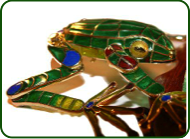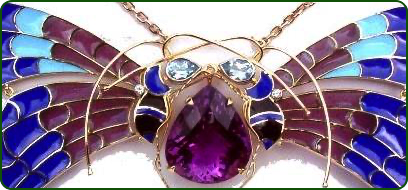Bernard Doherty Artist in Gold
Plique a’ Jour an explanation
Copyright all images and designs Bernard Doherty 1948 - 2025

My jewellery is influenced by the Art Nouveau period of design. One of the chief principals of this style of jewellery is the aim to suggest reality using themes from nature.
The most important material used in Art Nouveau jewellery was enamel, for which Art Nouveau craftsmen developed new techniques and applications, Enamel is coloured glass, usually lead-soda or lead-potash, in powder form, which is fused to a metal surface under heat.
In cloisonné, the enamel fills little cloisons (cells) of metal which separate the various colours, so that the outlines of the metal show on the surface. The cells are made of narrow strips of metal wire which have been soldered to the base. An extension of this technique is plique a` jour, which was undoubtedly the most inventive and important technique in Art Nouveau jewellery, as well as being one of the most difficult of all enamelling processes. It produced an effect like that of stained-glass windows. Plique a' jour was not a new process. It is said to have been used by Byzantine craftsmen but had passed into oblivion. Experiments went on in France in the second half of the nineteenth century to revive the technique and there are varying opinions as to who should receive the credit for its revival. The technique was almost lost in the last part of the twentieth century also but has been kept alive by a few craftsmen in Europe the USA and Australia. Its rediscovery in the nineteenth century is often attributed to André Fernand Thesmar, who used the technique of copper plate backing and made enamel Art Nouveau jewellery and objects of distinctive, richly coloured character.
Plique a` jour is constructed with cells like cloisonné, but is left open at the back so that light can shine through the translucent enamel. There were originally at least two ways of achieving this effect.The metal cloisons could be laid onto a base to which the enamel would not adhere when it was fired, and the base removed after firing. Alternatively, a sheet of copper foil could be used as the backing and then dissolved after firing by soaking in acid. There is also the technique I use of suspending the enamel using the process of capillary gap and attraction. In this method the enamel is mixed with a glue like substance. In all cases, the partitions are filled with enamel in the same way as with cloisonné. The disadvantages of Plique a` jour are its fragility and the high degree of skill it therefore demands. Lalique, who made Plique a` jour from 1898 to 1905, improved the method by using saw-pierced sheets of gold for the cloisons, usually with a copper backing, which made a much sturdier framework. This method produced an effect which suited the interpretation of the filmy veined membranes in nature, especially insect wings and the crisp, brittle translucency of leaves permitting a greater play of light. Reference: Art Nouveau Jewellery - Thames and Hudson 1985 by Vivienne Becker
